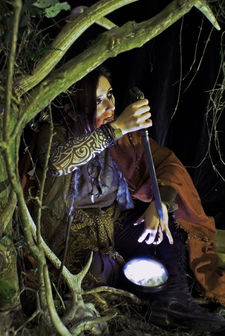Navarr culture and customs
The Great Dance
The central philosophy of the Navarr is the idea that life is a Great Dance in which all humankind is engaged. Some may lead, some may follow; but the Dance is better for everyone when the dancers have the right partners at the right time and place. Many Navarr try to help people find their place and their partners in the Great Dance. People who do not feel ‘right’ where they are should be encouraged to travel to find a new place in the Great Dance, a chance to find a place they will belong, where their partners will be right for them.
Reincarnation is central to this belief - to the Navarr the dead are simply resting for a while before they resume their place. People who find their perfect partner in the Dance are destined to find that partner again and again each time they are born. A partner may not always be a lover, it could be a sibling or simply a close friend.
Vows
The Navarr mark vows, oaths and promises with a physical sign of their intent and commitment, often through tatooing or scarification. The more enduring the commitment, the more permanent the marks. War-paint is applied before a battle, henna tattoos are used for commitments that last a few days or more and permanent pledges or those that will take years to complete are usually marked with tattoos. The Navarr mark the most significant vows with brands. These marks help hold a person to their pledge, but they also make it easier for others to identify those who have sworn themselves to a given role or cause (as discussed in Hearth Magic).
Celebrations
The Navarr have a long tradition of marking important moments in their lives with celebrations. Usually these take the form of a shared meal followed by dancing, drinking and gaming. Marking important times strengthens the links between members of a community - especially an extended community such as the Navarr possess. Three important celebrations observed by the majority of the Navarr are Unburdening, The Binding of Thorns and Welcoming.
Unburdening
Navarr Stridings and Steadings are not fixed – they shift and change over time, as people die, retire or move from one to another, perhaps due to a love-match or to a desire to see other climes. When an individual decides to leave a Steading to join a Striding (or even just to travel to another Steading), the event is celebrated with a simple feast in which they ceremonially burn a list describing the belongings they are leaving behind. This symbolises an intent to give up ownership, and comes with a general assumption that these possessions can be claimed by or redistributed among the Navarr who remain behind. The Navarr are far too pragmatic to burn valuable goods, but the ceremony helps people to let go of the things they do not need.
The Binding of Thorns
When a child passes their test of adulthood they undergo the Binding of Thorns. This important ceremony marks them as a true Navarr. The participants swear the same oath their ancestors swore centuries earlier when their cities were destroyed by the Vallorn and they began their endless migrations. Once the oath is taken, the new Navarr mingle their blood with all other Navarr who have attended the ceremony, and receive the traditional Navarr tattoo. All Navarr who have undergone the Binding of Thorns bear this tattoo, one of endless variations on the motif of briars of intertwined thorns. This ceremony is also used when an adult from outside the Navarr wishes to become one of them.
The Binding reminds the new Navarr that wherever they go they are part of the Navarr, and that regaining the remnants of their former civilisation from the Vallorn is their ancient purpose.
Welcoming
Conscious of the passage of the seasons, the Navarr Stridings congregate at festival times, either together or at the Steadings. The Navarr celebrate the turning of all the seasons but the birth of a new spring and the end of the harsh winter that makes travelling difficult is their major festival. This grand celebration is a time for revelry, feasting, raucous music and wild dancing. It is also traditionally a time for making a new start, abandoning grudges and putting aside past failures to concentrate on the possibilities of a new year.
Welcoming begins with a ceremonial hunt. The traditional quarry of the Welcoming are the Vates, who often adopt fanciful costumes or headdresses that represent game animals, such as stag, hares and pigeons. Details of the hunt vary from year to year; a glorified game of hide-and-seek one year may be followed by a mock hunt through light woodland the next, or a chase across open ground. The hunt is good natured, but some Vates relish the opportunity to employ their magic to make the hunt more exciting.
Funerals
Come, come why the tears my sweet? Death is just another step in the Great Dance.
Nana Isabella WordlessIn death, what remains are the memories of your deeds in the minds of your partners in the Great Dance. The Steadings use a traditional corpse-glade where the bodies are laid out in the forest. Such glades are rarely troubled by scavengers or carrion-eaters, and the bodies are simply left undisturbed to moulder.
The Stridings usually commit bodies to simple cairn but a Striding may decide to transport a corpse to a Steading before performing a funeral. There is also a custom where the friends of the deceased make a pilgrimage to a corpse-glade to hang a reminder or memento of their fallen comrade among the branches.

